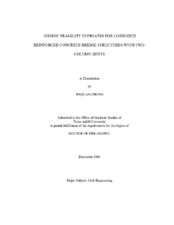| dc.description.abstract | To assess the losses associated with future earthquakes, seismic vulnerability
functions are commonly used to correlate the damage or loss of a structure to the level of
seismic intensity. A common procedure in seismic vulnerability assessment is to
estimate the seismic fragility, which is defined as the conditional probability that a
structure fails to meet the specific performance level for given level of seismic intensity.
This dissertation proposes a methodology to estimate the fragility of corroded
reinforced concrete (RC) bridges with two-column bents subject to seismic excitation.
Seismic fragility functions are first developed for the RC bridges with two-column bents.
All available information from science/engineering laws, numerical analysis, laboratory
experiments, and field measurements has been used to construct the proper form of the
fragility functions. The fragility functions are formulated, at the individual column,
bent, and bridge levels, in terms of the spectral acceleration and the ratio between the
peak ground velocity and the peak ground acceleration. The developed fragility
functions properly account for the prevailing uncertainties in fragility estimation. The probabilistic capacity and demand models are then combined with the probabilistic
models for chloride-induced corrosion and the time-dependent corrosion rate. The
fragility estimates for corroded RC bridges incorporates the uncertainties in the
parameters of capacity and demand models, and the inexactness (or model error) in
modeling the material deterioration, structural capacity, and seismic demands. The
proposed methodology is illustrated by developing the fragility functions for an example
RC bridge with 11 two-column bents representing current construction in California.
The developed fragility functions provide valuable information to allocate and
spend available funds for the design, maintenance, and retrofitting of structures and
networks. This study regarding the vulnerability of corroding RC bridges will be of
direct value to those making decisions about the condition assessment, residual life, and
the ability of lifeline structures to withstand future seismic demands. | en |


